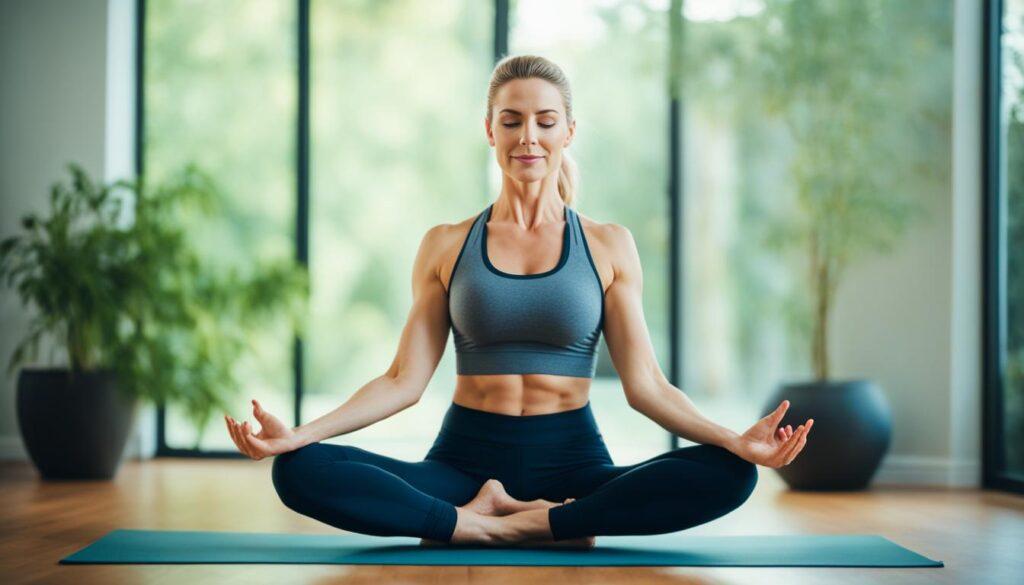To achieve a toned midsection and improved posture, it’s crucial to focus on core strength through structured ab exercise routines. While diet plays a role in revealing your abs, it is training that shapes and develops them. Understanding the different muscles in your core is key to designing an effective workout routine that targets each muscle group.
The rectus abdominis, consisting of upper and lower abs, forms the coveted “six-pack.” The obliques run along the sides of the abs, adding definition to your waistline. The serratus anterior, located on top of the ribs, adds even more definition and contributes to shoulder health. By targeting all these muscles, you can develop a well-rounded and impressive midsection.
With the overwhelming number of ab exercises available, it can be challenging to determine which ones are most effective. In this article, we will provide a structured approach to ab workouts based on scientific research and core anatomy understanding. By following these guidelines and incorporating the recommended exercises, you can build a stronger core and achieve the toned midsection you desire.
Key Takeaways:
- Structured ab exercise routines are essential for developing a stronger core.
- Focusing on different muscles in the core, including the rectus abdominis, obliques, and serratus anterior, is important for a well-rounded midsection.
- Choosing the right exercises based on scientific research and core anatomy understanding is crucial for effectiveness.
- By incorporating these exercises, you can improve your posture and achieve a toned midsection.
- Consistency and proper form are key to achieving the desired results.
Understanding the Basic Anatomy of the Core Muscles
When it comes to building a strong and toned core, understanding the basic anatomy of the core muscles is essential. The core muscles consist of the rectus abdominis, obliques, and serratus anterior. Let’s take a closer look at each of these muscle groups and their role in achieving a well-rounded midsection.
Rectus Abdominis: Upper Abs and Lower Abs
The rectus abdominis is often referred to as the “six-pack” muscle. It is the primary muscle group responsible for the defined abdominal appearance that so many individuals strive for. The rectus abdominis can be further divided into the upper abs and lower abs.
Each region of the rectus abdominis can be selectively activated, as they are innervated by different nerves. This means that by targeting specific areas of the rectus abdominis, you can emphasize the development of your upper abs or lower abs.
Obliques: Defines Your Waistline
The obliques are located on the sides of the abs and play a significant role in defining your waistline. These muscles contribute to the overall appearance of your midsection, adding depth and definition to your core.
Serratus Anterior: Definition and Shoulder Health
The serratus anterior is positioned on top of the ribs and adds even more definition to your midsection. This muscle not only contributes to a well-rounded and impressive core, but it also plays a vital role in shoulder health. Strengthening the serratus anterior can help prevent shoulder injuries and improve overall shoulder stability.
Now that we have a better understanding of the core muscles and their roles in sculpting a strong midsection, it’s time to design an abs routine that targets each of these muscle groups effectively.
The Best Ab Exercise Routines for Six-Pack Abs
When it comes to building a well-developed and impressive midsection, incorporating the right ab exercises into your routine is key. From targeting the lower abs to engaging the obliques and serratus anterior, a comprehensive workout plan will help you achieve the six-pack abs you desire.
1. Reverse Crunch: Activating the Lower Abs
The reverse crunch is a bottom-up abs exercise that effectively targets the lower abs. To perform this exercise correctly, initiate a posterior pelvic tilt and curl your pelvis up towards your belly button. This proper form will significantly increase the activation of your lower abs, leading to better results.
2. High to Low Woodchoppers: Engaging the Obliques
For a rotational movement that targets the obliques, high to low woodchoppers are highly effective. Rotate your torso from side to side while keeping your legs pointed forward. This exercise helps define your waistline and strengthens the oblique muscles.
3. Anti-Rotation Exercises: Strengthening the Core
To prevent rotation and develop core stability, incorporate anti-rotation exercises into your routine. Plank reaches and off-center hollow holds are excellent options for strengthening the core muscles responsible for resisting rotation.
4. Weighted Crunches: Targeting the Upper Abs
To target your upper abs, emphasize the top-down movement with weighted crunches. Bring your rib cage forward and down towards your pelvis, focusing on engaging the upper abdominal muscles. This exercise will help develop definition and strength in the upper region of your abs.
5. Serratus Jabs: Supporting Shoulder Health
Don’t forget to incorporate exercises that engage the serratus anterior muscle, crucial for shoulder health and injury prevention. Perform serratus jabs using a band or cable to activate and strengthen this muscle. In addition to building a strong core, serratus jabs contribute to overall upper body stability and functionality.
By including these exercises in your ab routine, you’ll be targeting all the necessary muscles to achieve a well-developed and impressive midsection. Remember to focus on proper form and activation for optimal results. Consistency and dedication to your ab workouts will bring you closer to your goal of six-pack abs.
Key Ab Exercises for Six-Pack Abs
| Exercise | Targeted Muscles |
|---|---|
| Reverse Crunch | Lower Abs |
| High to Low Woodchoppers | Obliques |
| Anti-Rotation Exercises | Core Muscles |
| Weighted Crunches | Upper Abs |
| Serratus Jabs | Serratus Anterior |
Quick and Effective Ab Workouts for Time-Crunched Individuals
Building a strong core doesn’t always require hours of training. With a strategic approach, you can achieve effective ab workouts in as little as 15 minutes. To design a comprehensive ab workout plan, it’s essential to understand the different aspects of core training.
Core training can be divided into four categories: bracing, rotation, anti-rotation, and spinal flexion. Bracing exercises, such as planks and hollow holds, engage the entire core to keep the spine stable. Rotation exercises focus on rotating the torso, while anti-rotation exercises strengthen the core muscles that prevent rotation. Spinal flexion exercises, like the Pilates ab crunch, can be included in a well-rounded core workout.
By incorporating these exercises into a 15-minute routine, you can effectively develop a strong and toned core, even with a busy schedule. Remember, consistency is key, so strive to perform these workouts at least three times a week.
| Category | Examples of Exercises |
|---|---|
| Bracing | Plank, Hollow Hold |
| Rotation | Russian Twists, Standing Oblique Crunches |
| Anti-Rotation | Pallof Press, Standing Band Rotations |
| Spinal Flexion | Pilates Ab Crunch, Bicycle Crunches |
Warm-up Exercises
Prior to starting your ab workout, it’s important to warm up your core and prepare your muscles for the exercises ahead. Here are a few warm-up exercises you can incorporate:
- Pelvic Tilt – Lie on your back with your knees bent. Gently tilt your pelvis upward, engaging your core muscles.
- Bridge – Lie on your back with your knees bent and feet flat on the floor. Press your hips upward, engaging your glutes and core.
Perform each warm-up exercise for 10-15 reps, focusing on maintaining proper form and engaging your core throughout.
Remember, while these quick ab workouts can be effective, it’s important to listen to your body and modify exercises as needed. If you experience any pain or discomfort, consult with a healthcare professional before continuing your workout routine.
 Stay committed to your core training regimen, and with time, you’ll notice improvements in both strength and definition in your abs.
Stay committed to your core training regimen, and with time, you’ll notice improvements in both strength and definition in your abs.
Developing a Back-Friendly Workout Plan with Core Strengthening Exercises
Back pain is a common issue that many individuals struggle with, and strengthening the core can help alleviate and prevent this discomfort. Incorporating Pilates-style moves into a workout routine can be beneficial for individuals with back pain. Focusing on engaging the transverse abdominis, a deep core muscle, can improve form and stability in exercises like squats and lunges. By performing Pilates-inspired exercises that target the core, such as the pelvic tilt, Cobra, wide leg open toe squat, and ab curl hollow hold, you can strengthen your core and manage back pain more effectively.
Developing a back-friendly workout plan requires a thoughtful approach to core strengthening exercises. By focusing on the transverse abdominis, you can improve the stability of your spine and reduce the risk of back pain. Pilates-style moves are particularly effective for this purpose, as they emphasize core engagement and proper form. Here are some core strengthening exercises that can help alleviate back pain:
- Pelvic Tilt: Lie on your back with your knees bent and feet flat on the floor. Slowly tilt your pelvis back, pressing your lower back into the floor. Hold for a few seconds and release. Repeat for several reps.
- Cobra: Lie on your stomach with your palms on the floor under your shoulders. Slowly lift your upper body off the floor, keeping your pelvis and legs on the ground. Hold for a few seconds and lower back down. Repeat for several reps.
- Wide Leg Open Toe Squat: Stand with your feet wider than hip-width apart and toes turned out. Lower into a squat position, keeping your knees tracking over your toes. Hold for a few seconds and rise back up. Repeat for several reps.
- Ab Curl Hollow Hold: Lie on your back with your legs extended and arms extended overhead. Simultaneously lift your head, shoulders, and legs off the ground, forming a “V” shape with your body. Hold for a few seconds and lower back down. Repeat for several reps.
Performing these exercises regularly as part of your workout routine can help strengthen your core muscles and improve spinal stability, reducing the risk of back pain. Remember to focus on maintaining proper form and engaging your core throughout each exercise.
Quote: “Incorporating Pilates-style exercises into your core workout routine can be a game-changer for individuals struggling with back pain. By targeting the deep core muscles, such as the transverse abdominis, you can improve stability and relieve discomfort.” – Dr. Samantha Reynolds, Physical Therapist
Conclusion
Building a strong core and achieving toned abs requires a combination of structured workouts and effective exercises. By targeting all the muscles in your core, including the rectus abdominis, obliques, and serratus anterior, you can develop a well-rounded and impressive midsection. Incorporating exercises such as reverse crunches, rotational movements, weighted crunches, and serratus jabs into your ab routine can lead to significant improvements in core strength and appearance.
If you’re short on time, don’t worry! Quick and effective ab workouts can still provide results in as little as 15 minutes. By understanding the different aspects of core training and including exercises that focus on bracing, rotation, anti-rotation, and spinal flexion, you can develop a strong and stable core even with a busy schedule.
For those dealing with back pain, incorporating Pilates-style moves and focusing on engaging the transverse abdominis can help alleviate and prevent discomfort. Strengthening your core is crucial for maintaining proper posture and spinal support, which can ultimately contribute to back pain prevention.
So, whether you’re looking to build a strong core, achieve toned abs, or prevent back pain, following a structured ab exercise routine and incorporating effective exercises will set you on the right track. Start incorporating these strategies into your workout routine today and watch as your core becomes stronger, your abs become more toned, and your overall fitness reaches new heights.








